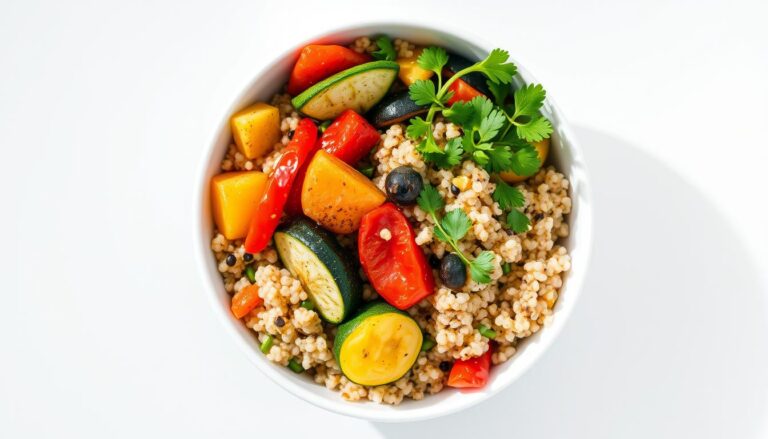
Are you ready to unlock the secrets of intermittent fasting? It’s a popular trend for good reasons. It helps with weight loss, improves insulin sensitivity, and boosts longevity.
As you start your journey, you might wonder what it’s all about. You might ask how to begin with an intermittent fasting guide.
Key Takeaways
- Intermittent fasting is an eating pattern that involves alternating periods of fasting and eating to promote weight loss and improve metabolic health.
- There are various intermittent fasting methods, including the 16:8 method and the 5:2 approach, which can be tailored to suit your lifestyle and preferences.
- Research indicates that intermittent fasting can have numerous health benefits, including improved blood pressure, resting heart rates, and weight loss.
- It’s essential to consult with a healthcare professional before starting an intermittent fasting regimen, especially if you have any underlying medical conditions.
- With the right intermittent fasting guide, you can learn how to start intermittent fasting and achieve your health and wellness goals.
What Is Intermittent Fasting: Understanding the Basics
Starting your journey with intermittent fasting? It’s key to know the basics. This eating pattern means you eat less for certain times. These times can be from 12 hours to days. It helps with weight loss, better insulin use, and less inflammation.
Choosing the right fasting schedule is crucial. There are many types, like the 16/8 method and the 5:2 diet. Each has its own good and bad points. For instance, the 16/8 method means fasting for 16 hours and eating in 8 hours. The 5:2 diet lets you eat normally for 5 days and limits calories on the other 2.
Following a good fasting schedule and using helpful tips can help you reach your health goals. Always pay attention to how your body feels and adjust your fasting plan if needed. With time and effort, you can see the benefits of intermittent fasting and feel better overall.
The Powerful Benefits of Intermittent Fasting
Starting intermittent fasting brings big benefits of intermittent fasting. You might lose weight, get better insulin control, and live longer. Studies show people lose about 9% of their body weight in 12 weeks.
A good intermittent fasting meal plan helps you get these benefits. The main perks of intermittent fasting are:
- Weight loss: You can lose a lot of weight, up to 13% of your body weight.
- Improved insulin sensitivity: It lowers blood sugar and makes insulin work better.
- Increased longevity: It might even make you live longer, with mice living 13% longer.
Intermittent fasting is great for health and wellbeing. By adding intermittent fasting to your life and following a good intermittent fasting meal plan, you can see big changes. You’ll feel better overall.

Getting Started with Intermittent Fasting: A Beginner’s Guide
Starting intermittent fasting might seem hard, but it’s easy. First, pick a fasting plan like 16/8 or 5:2. When getting started with intermittent fasting, set your eating times and plan meals.
A good beginners’ intermittent fasting plan includes healthy foods. This ensures you get enough nutrients. Some intermittent fasting tips for beginners are to listen to your body and drink lots of water.
Here are some key points to consider when starting your intermittent fasting journey:
- Choose a fasting schedule that fits your lifestyle
- Plan your meals in advance to ensure you’re getting enough nutrients
- Stay hydrated by drinking plenty of water

Follow these tips and stay consistent. You’ll get started with intermittent fasting and see its benefits.
The Most Popular Intermittent Fasting Methods
Intermittent fasting has many methods, each with its own benefits and challenges. For easy intermittent fasting for beginners, the 16/8 method is a good choice. It means fasting for 16 hours and eating in an 8-hour window. This is perfect for those starting out with intermittent fasting weight loss.
The 5:2 diet is also popular. You eat normally for 5 days and limit calories to 500-600 on the other 2 days. The Eat-Stop-Eat method is more advanced, fasting for 24 hours once or twice a week. These methods work well for intermittent fasting 16/8 and other types.
Here are some key points to consider for each method:
- 16/8 method: fast for 16 hours, eat within an 8-hour window
- 5:2 diet: eat normally for 5 days, restrict calories to 500-600 on the other 2 days
- Eat-Stop-Eat approach: fast for 24 hours once or twice a week
It’s important to pick a method that suits your lifestyle and talk to a healthcare professional before starting. With the right method, intermittent fasting weight loss can help you reach your health goals.

Creating Your Intermittent Fasting Meal Plan
For intermittent fasting for weight loss, a good meal plan is key. You need to plan what to eat when you can and make sure you get enough nutrients. A good intermittent fasting meal plan should have protein, healthy fats, and complex carbs.
Start by thinking about what you like to eat and what fits your intermittent fasting for weight loss goals. It’s also important to listen to your body and change your meal plan if needed. The benefits of intermittent fasting are big, but it must fit your lifestyle.
Here are some tips for your intermittent fasting meal plan:
- Eat nutrient-dense foods during your eating window
- Stay hydrated by drinking plenty of water
- Be mindful of your calorie intake on non-fasting days

Remember, a successful intermittent fasting meal plan is about balance. With some planning and creativity, you can enjoy the benefits of intermittent fasting and still eat what you love.
Common Challenges and How to Overcome Them
Starting intermittent fasting can be tough. One big challenge is hunger pangs. To beat this, drink lots of water and eat foods rich in nutrients when you can eat.
This makes you feel full and happy. It helps you stick to your fasting plan.
Another challenge is eating out with friends. But, with a bit of planning, you can still join in. Eat before you go out or choose a later eating time to fit your schedule.
Remember, the good things about fasting, like losing weight and better blood sugar, are worth it.

It’s key to drink lots of water while fasting to stay healthy. Aim for 2 liters a day. Also, try eating every 3 to 4 hours when you can to keep your energy up and hunger down.
By following these tips and staying true to your fasting plan, you can beat common problems. You’ll get the benefits of fasting, like better health and feeling good.
Tracking Your Progress and Results
As you keep up with intermittent fasting, it’s key to track your progress. This keeps you motivated and lets you tweak your fasting plan if needed. You can see your intermittent fasting results by watching your weight, body fat, and health markers.
One big intermittent fasting benefit is losing weight. But, remember to look at your overall health, not just the scale. Use a food diary or app to keep track of what you eat and see your intermittent fasting weight loss.
There are lots of apps and tools to help you track your journey. Zero, BodyFast, and Simple are some popular ones. They let you set fasting plans, track your progress, and connect with others. These tools help you stay on track and reach your intermittent fasting results goals.

Tracking your progress is a big part of intermittent fasting. By watching your progress and making changes, you can hit your health goals. And enjoy all the intermittent fasting benefits this lifestyle offers.
Exercise and Intermittent Fasting: What You Need to Know
When you start with intermittent fasting for weight loss, you might ask how to add exercise. Mixing exercise with fasting can boost your health even more. When you fast, your body starts using fat for energy instead of sugar.
This change is good for your health. It can lower your risk of diabetes and help control blood pressure. Exercise makes your body burn more fat for energy. For instance, studies show that working out while fasting can burn more fat because your glycogen stores are low.
Here are some important things to think about when you mix fasting and exercise:
- Listen to your body and adjust your plan if you feel dizzy or weak.
- Drink more water to stay hydrated.
- Eat about 20 grams of protein within 30 minutes after strength training to help your muscles recover.

Adding exercise to your fasting routine can help you lose weight and get healthier. Just remember to listen to your body and adjust your plan to keep it safe and effective.
Tips for Long-Term Success with Intermittent Fasting
To succeed with intermittent fasting, focus on building lasting habits. Adjust your schedule as needed. Create a routine that fits you and stick to it. Be flexible to make changes when needed.
Intermittent fasting can improve your health. It can lower blood pressure and heart rate. It also helps with glucose regulation and losing belly fat.

Stay hydrated, especially on fasting days. Avoid sugary drinks to keep blood sugar stable.
Listen to your body and adjust your schedule if needed. If you feel weak or have other negative effects, change your approach. This way, you can have a positive fasting experience.
Some key takeaways for long-term success with intermittent fasting include:
- Start small and gradually increase the duration of your fasts
- Stay hydrated and avoid sugary drinks
- Listen to your body and adjust your schedule as needed
- Focus on building sustainable habits and making intermittent fasting a lifestyle
By following these tips and finding a schedule that works for you, you can enjoy the benefits of intermittent fasting. Achieve long-term success and reach your health goals.
Safety Considerations and Who Should Avoid Fasting
When thinking about intermittent fasting safety, it’s key to look at medical conditions and who should not fast. The benefits of intermittent fasting are many, like losing weight and better health. But, your health and safety come first.
Medical Conditions to Consider
- People with heart disease or type 2 diabetes
- Those trying to conceive, pregnant, or nursing
- Individuals who are underweight or have a history of eating disorders
Intermittent fasting for weight loss might not be right for everyone, especially those with certain health issues. If you’re thinking about trying it, talk to your doctor first. They can figure out what’s best for you.
When to Consult Your Healthcare Provider
Always talk to your doctor before starting a new diet or fasting plan, especially if you have health problems. They can guide you on what’s best for your health and safety.

By focusing on your health and safety, you can enjoy the benefits of intermittent fasting without risks. Always check with your doctor before starting any new diet or fasting plan, especially for intermittent fasting for weight loss.
Conclusion: Your Journey to Successful Intermittent Fasting Starts Now
Your journey to successful intermittent fasting has just begun! You now have the knowledge and tools to start this powerful lifestyle change. Remember, it’s okay to take it one step at a time.
Don’t be too hard on yourself if you encounter setbacks. Instead, focus on getting back on track as soon as possible. With patience, persistence, and the right mindset, you can achieve your health and weight loss goals.
Remember, the key to long-term success is making intermittent fasting a lifestyle. Experiment with different fasting methods, listen to your body, and make adjustments as needed. With time and practice, it will become a natural part of your daily routine.
Your journey to better health and wellbeing starts now. Embrace the process, celebrate your successes, and stay motivated. The benefits of intermittent fasting are within your reach. Good luck on your transformative journey!















